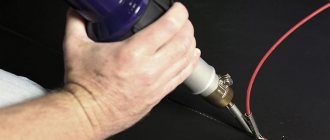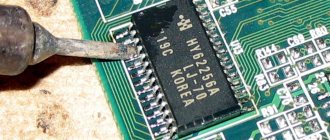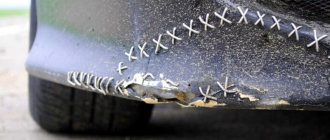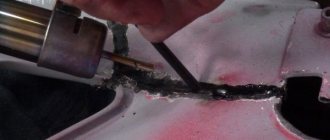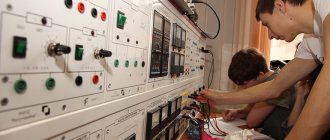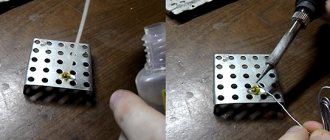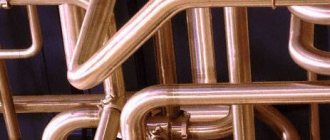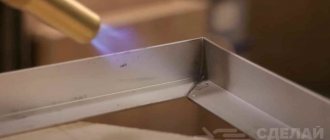The subtleties of good soldering
To solder a part to the board, you need:
1) Apply flux to the soldering surface; 2) Tin them with solder; 3) Apply flux to the contacts again; 4) Solder the gap between the contacts.
The first important rule is to avoid temperatures above 400°C or more. Many beginner (and even experienced) radio amateurs neglect this. These are critical values for microcircuits and boards.
Solder melts at approximately 180 to 230°C (lead-containing solders) or 180 to 250°C (lead-free). This is far from 400 °C. Why then set the temperature high?
What you need for reliable contact
Main criteria:
- Choose the right flux. For example, liquid flux is suitable for soldering wires. It wets wires best and allows for better tinning of such contacts. Low-quality flux quickly boils and spreads over the board.
- Use high quality solder. It is the solder that determines the further reliability and strength of the connection. Also, the quality of the solder can affect the operation of the circuit as a whole; due to slag and low-quality alloys, interference may occur in the operation of the electronics and, over time, cracks may appear.
- Use proven tools and equipment. Soldering irons of poor quality can maintain temperature unstably and overheat.
- Maintain temperature conditions. Do not overheat the parts and stay within the melting temperature of the solder. The temperature is too low and the solder will not melt well, and if it is too high, the material will evaporate, making it worse to tin the contacts.
- Long hours of practice, trial and error. Without practice, there will be no soldering method.
These criteria are interrelated with each other. And with a poor choice of components and materials, the same result will occur.
Selection of fluxes and solders
Since the quality of soldering joints largely depends on the correct choice of fluxes and solders, these materials should be considered in more detail. Currently, there are a large number of these components suitable for almost all types of soldering.
The main function of fluxes is to pickle metal parts, remove the oxide film and subsequently protect the surface from corrosion. Flux coating ensures its cleanliness, good wetting and spreading of tin.
Fluxes are selected in accordance with the metals and alloys that need to be joined. The composition of any flux includes metal salts, alkalis and acids that actively react to increased temperature. In this regard, there is a conditional division of these materials into two types.
The first of them is active; it is based on hydrochloric, perchloric and other inorganic acids. Their aggressive effect on metal requires quick rinsing after finishing work. This is the only drawback of such fluxes, but with their help you can join almost any metals. They are available in liquid form and are considered more convenient for application. They add alcohol or glycerin, which completely evaporate when heated.
The second type of flux consists of rosin and is used for joining non-ferrous metals. For steel parts they are considered less effective. At the end of the work, the rosin must be washed off, since over time it causes corrosion and becomes an electrical conductor when left in a humid environment for a long time.
Solder for work is easier to select. Lead and tin compounds marked PIC are mainly used. The percentage of tin content is indicated by numbers following the letters. A higher tin content in solder provides higher mechanical strength and electrical conductivity of connections. At the same time, the melting temperature of solder with a high proportion of tin also decreases. The addition of lead normalizes solidification and prevents the tin from spreading.
Where to begin
First, you need to decide for what purpose you need soldering. For amateur radio, this is an entry-level level; for soldering wiring and a simple level, more professional tools are needed. And to repair and solder SMD and BGA microcircuits, you will have to learn all the basics of soldering and purchase special tools and consumables.
Choosing the Right Soldering Kit
Solders come in different types and diameters.
A large solder diameter is convenient for soldering wires, and small diameters are suitable for spot soldering SMD components or connectors. Solders also come with or without rosin. With rosin, solder is very convenient. It is easiest to use it on a soldering iron tip.
Starter Kit
For radio amateurs, stores sell everything at once in one pack. Such sets are the cheapest, since everything will cost more separately. For example, there are sets with a soldering iron and tips, as well as tweezers.
Soldering iron or station
For soldering radio components and wires, a simple soldering iron with a copper tip is sufficient. But for more advanced soldering you will need a station. A soldering station usually consists of a hair dryer and a soldering iron. Using a hair dryer, you can solder SMD components, and you will be able to warm up the board better.
It is best to start with a soldering iron and choose one that has temperature control and changeable tips.
Soldering iron tips
There is an arsenal of tips for soldering irons. Cone, flat, hatchet, wave, etc. They can all be of different sizes and shapes.
Soldering tip selection
A mini wave is perfect for beginners. This type of tip is the easiest to tin and is capable of a wide range of tasks.
Features of application
For soldering wires these are massive tips, and for planar contacts these are usually conical and curved tips. For example, to solder a cable from a board, a hatchet is best suited. This type has a wide working surface, which allows you to massively heat a large surface of the board.
Eternal stings and rules for their use
The main rule when using permanent tips is that there should always be solder or flux on the tip. If you ignore this rule, black dots will begin to appear on the sting, which will eventually spread to the entire surface.
This is a layer of soot that forms when air oxidizes on the working surface. Solder or flux perform a protective function, and during operation of the soldering iron they, and not the soldering iron tip, are oxidized.
Why did the soldering iron start to solder poorly?
If the soldering iron melts the solder, but does not take it to its working surface, then it needs to be tinned. It is highly oxidized, but should not be thrown away.
Preparing for work
After turning on the soldering iron, you need to wait for it to heat up. All preparation comes down to cleaning carbon deposits from the working surface and applying solder. When working with stings, do not use cutting tools. Do not remove carbon deposits from the soldering iron with blades or other sharp objects.
Soldering iron tinning
Tinning a soldering iron occurs in stages:
- The heated tip needs to be cleaned. Using a wet sponge or copper shavings.
- Solder was applied to a clean surface.
The black surface of the tip is removed by long tinning. This is done using a lump of solder and flux. The tip is drowned in solder until it is clean. Periodically it should be dipped in solder. And then clean again with a sponge. In this case, it is best to use copper shavings; they remove oxides and carbon deposits much better. A wet sponge only removes solder, not carbon deposits. If the above methods do not help, then you will have to use a tip activator or soldering acid.
Hair dryer nozzles
The soldering gun also has its own attachments. They come in different diameters, shapes and fastenings. It all depends on what kind of work is being done.
Soldering flux selection
Soldering work has a wide range. And different tasks require different materials. For example, for soldering wires, nothing beats regular rosin. Rosin is cheap, practical and easy to use. But for microcircuits a different approach is needed. Paste-like flux and syringe for precise dosing of flux to SMD components.
How to clean flux after soldering
Using Galosh gasoline or alcohol.
Tools and consumables for cleaning:
- Cotton wool;
- Cotton pads;
- Cotton sticks;
- Toothbrush.
Workplace and additional tools
A wooden table is suitable for the workplace. If you don’t want to spoil the surface of the table, you can use a wooden plank. Wood absorbs little heat and does not act as a radiator. And if you don’t have such a board, you can purchase a silicone heat-resistant mat. This mat has a convenient area for disassembling electronics, various pockets and places for tools. The mat can be cleaned with regular alcohol after use if there are any stains or traces of solder.
Tweezers and spatulas
Using tweezers, you can move parts when soldering, position and install parts. They are also made from different materials, they can be angular, straight, with fixation, etc.
Optics and microscopes
Magnifiers are not very convenient, so it is much more convenient and practical to use microscopes. It's best to start with a budget option. For example, a simple USB microscope will allow you to evaluate the result of soldering on a computer screen.
Of course, the frame rate does not allow you to work normally under it, but it allows you to examine small details of the board without harm to your eyesight.
Room ventilation and safety rules
The room must have good ventilation. When soldering, you need to keep your distance and not get too close to avoid solder getting on your face. After soldering work, be sure to ventilate the room and wash your hands and face with soap. You should not eat food while soldering, because smoke residues remain on mucous surfaces.
Preparation
Work place
Soldering is always done under normal general lighting (no worse than 500 lux); if it is necessary to create more comfortable conditions, a local lighting source is used.
Good ventilation should be ensured. The best results are obtained by a hood; in its absence, solder intermittently to ventilate the room from rosin vapors (every hour during intensive work).
Selecting a soldering iron by power
Solder using soldering irons of varying power. It is usually assumed that:
- low-power soldering irons (20 – 50 W) are convenient for working with electronics and allow you to solder thin wires;
- A 100-watt tool is used to solder layers of copper no more than 1 mm thick;
- 200 W or more allows you to solder such massive parts that initially require the use of powerful soldering irons.
The power of the device is easy to judge visually: a 50-watt soldering iron turns out to be slightly larger than a fountain pen, while a 200-watt soldering iron has a total length of approximately 35-40 cm.
Soldering iron for work
Before using it for the first time, remove any remaining factory grease from the housing. Their burnout leads to the appearance of smoke and an unpleasant odor. Therefore, the soldering iron is turned on through an extension cord, exposing it outside through the window for a quarter of an hour.
Then the soldering iron tip is forged with a hammer: compacting the copper increases service life. The tip of the sting is shaped:
- at an angle or cut - for spot work (an example is shown in Figure 5);
- knife-shaped - with such a sting several contacts are soldered simultaneously (typical for microcircuits);
- special - they are used to solder some types of radio components.
Figure 5. An example of universal sharpening of a soldering iron tip and proper maintenance of its working area
Before you start soldering, you should clean the tip from the oxide film. This procedure is carried out with fine-grained sandpaper or a velvet file, as well as chemically: immersion in rosin. The cleaned tip is tinned with solder.
If necessary, you can solder at the point with a powerful soldering iron. To do this, a copper wire with a diameter of 0.5 - 1 mm is wound onto its tip, using its free end to heat the solder.
Parts for soldering
They always solder in several stages. First, prepare the surface of the metal conductor:
- removal of the oxide film followed by degreasing;
- tinning (applying a layer of tin to contacting surfaces).
Then you can connect the parts.
Be sure to clean used wires.
The oxide film is removed with a file, sandpaper, or a knife blade. In the case of flexible wires, each wire is processed.
The insulation of the enameled wire is removed by dragging it along the surface of a PVC tube, to which it is pressed with a heated tip.
A sign of readiness is a uniformly shiny surface without any remaining oxide film.
They always solder with degreasing, i.e. wipe the surface with a lint-free cloth or napkin moistened with acetone or white spirit.
New wires do not have an oxide film. They are serviced immediately after the insulation is removed.
It is necessary to tin the copper conductor using flux; after heating, the solder should cover the surface of the metal with a thin layer. If there are nodules, it is not recommended to solder; the wire is placed vertically, passing the soldering iron from top to bottom. Excess molten solder flows onto the tip.
If it is necessary to solder aluminum, then the stripping and tinning procedures are combined. To do this, place a wire coated with rosin in sandpaper, heat it while rotating it.
The quality of some types of flux decreases during long-term storage, as well as under the influence of air moisture. Therefore, such fluxes are soldered with additional shelf life control.
Simple soldering of wires
The first example is soldering wires.
What you need
To strip the insulation from the wires you will need a stripper.
It can be used to quickly remove insulation. Side cutters, wire cutters, a knife, teeth or a soldering iron will not be able to cope with this task as easily.
Liquid rosin, or FKET, is suitable for soldering wires.
Liquid rosin best coats the wire veins. It is cheap, practical and convenient.
Which sting is better to choose
Wires require a lot of solder. A mini wave is more practical for soldering any wires than a regular cone or flat tip.
Step by step process
We remove the insulation with a stripper and twist the wires.
We apply flux to the wires to be soldered, and take the solder onto the tip. The temperature of the tip is no more than 300 °C.
With several movements back and forth we tin the twisted wires. If the solder has formed into lumps, then add it and wait for the soldering area to cool down so as not to damage the brush. Add more flux and run the soldering iron over the soldering area again. There should not be much or little solder.
It's best to tin both wires before soldering them together, but you won't be able to twist them together securely. Therefore, it is easier to immediately twist and then solder them.
Headphone repair
The main problem when repairing headphones is the resistant insulation of the wires.
Features of wire tinning
To tin such wires, you need to carefully walk over the soldering area using solder and rosin.
For soldering you will need a massive tip, a large drop of solder and liquid rosin. Flux is applied in the same way, but soldering is a little different. Now the main task is to burn the insulation. This can be done with a large drop of solder. Using longitudinal movements back and forth, apply solder to the soldering area. Insulation burns slowly. There is no need to raise the temperature above 300 °C or use acid. If we can’t tin, then we try again, but instead of rosin we use LTI-120. This flux will help tin the wires no worse than soldering acid.
Soldering process and components
Solder plays a major role in soldering and the quality of its results. It must have a melting point significantly lower than the melting point of each of the conductors. Therefore, the most important metal in solder is tin, which melts at 231.9 °C. However, it cannot be used in its pure form, as pot sealers once learned. Good metal: does not oxidize, soft, ductile. But at temperatures below +18 ° C, tin becomes “bad”, and everything made from it or with the help of it can collapse. The fact is that the crystal lattice of tin has three variants of the spatial arrangement of atoms, and white tin, which behaves normally at temperatures above +18 ° C, becomes brittle and gray if the temperature decreases. Therefore, instead of tin, an alloy is always used, where tin is valued for its low melting point. The remaining metals of numerous modifications of solder in different proportions:
- lead;
- bismuth;
- cadmium.
Solder
These three metals are used in low-melting solders, since their melting point is not very high - no higher than 450 ° C. Low-melting solders are usually also called tin-lead solders, they are designated by the marking POS (POS-30, POS-40, POS-50, POS-60). POS-30 and POS-40 are popular in radio engineering. The higher the number, the higher the strength of the solder. There are compounds called Rose alloy or Voodoo alloy, the melting point of which is lower than the boiling point of water (75–80 ° C)! A board with such a composition applied to it can be tinned by simply dipping it into boiling water. Low-melting solders are produced in the form of rods and wire with a diameter of 1 mm or in the form of the same tube filled with flux.
Low melting point solder
The following metals are components of refractory solders:
- copper;
- zinc;
- antimony
Refractory Solder Components
Refractory solders provide good strength characteristics of solders, their durability and even flexibility, but in non-factory conditions they are difficult to deal with. But when working with miniature radio circuits it is impossible due to the greater required heating. Their melting temperatures range from 450–830 °C.
Tinning of enameled wire
Enameled copper wire has a heat capacity and is difficult to tinning.
But it can be easily tinned using ordinary rosin. Sandpaper is enough.
We remove the enamel coating using sandpaper, apply rosin and the wire is successfully crimped and ready for soldering.
Where can I learn to solder?
You can train at home by soldering ordinary electrical wires. The main thing is to follow the safety instructions.
The work may require:
- soldering iron (according to professionals, to work with small wires in electronics and radio engineering, a tool with a power of 20-40 W will be sufficient);
- pliers;
- knife;
- scissors;
- set of files;
- sandpaper;
- insulating tape;
- rosin;
- solder.
The question “how to learn to solder” will be resolved after several training sessions. The beginner will gain confidence and experience. Step-by-step soldering instructions can help him with this.
Soldering LED strip
The LED strip has the same heat capacity as a thick wire. It contains a copper substrate, which absorbs heat when heated.
We tin the contacts using rosin. We use a mini wave and very little solder. There should be some solder at the soldering area.
Next, we take the soldering iron away from us with the handle, lean the wire against the contact and on top with the tip of the soldering iron. Soldering should take no longer than a second while there is flux. This is due to the fact that the copper substrate quickly absorbs heat, and the burning flux is no longer able to assemble the solder into a single whole. Therefore, if soldering work lasts more than a second, then there will be lumps of solder on the tape with signs of cold contact. If this happens, apply flux again and correct the bad soldering with one touch.
Rosin (flux) can be cleaned from the tape using alcohol (or gasoline) and a cotton pad.
Foil as a soldering method
The soldering method using foil is characterized by practicality. Typically, it only takes 5 minutes to restore the connection. Foil can be used as solder, which is unwound over the entire area and heated to a high temperature. Due to this, the plasticity of the material increases significantly; after cooling, it hardens.
Foil can be used in a variety of cases. An example is damage to the board or wire connection. Among the features of the work carried out, we note the following points:
- Standard contact preparation is carried out.
- The ends are twisted to form a joint. Due to this, the reliability of the connection is significantly increased.
- The required amount of foil is cut off, the junction is wrapped in several skeins.
After this, uniform heating is carried out using a hair dryer or other heat source. When exposed to heat, the surface of the foil quickly becomes soft and plastic; after heating stops, it quickly cools and hardens, providing the required degree of sealing and strength.
In conclusion, we note that without a soldering iron it is almost impossible to carry out jewelry work, as well as soldering circuit boards. This is due to the lack of possibility of directed heat exposure. However, in some cases a soldering iron and other tools are not required.
Educational program for beginners
To desolder a part from a board, you need to make sure that the contacts are heated until the solder melts (approximately 230 °C). The main mistake beginners make is to immediately heat the place where they are soldering to 300 - 350 °C.
For example, you need to desolder a microcircuit from a board using a Lukey 702 soldering station.
Many radio amateurs and electronics engineers set heating parameters above 300 °C.
At the first moment, the part is exposed to about 200 °C. The contacts and the surrounding area of soldering work are at room temperature.
The heating of the part reaches 300 °C, but the contacts have not yet reached 200 °C.
The microcircuit experiences a critical temperature of 350 °C. Meanwhile, the surrounding soldering area is heated unevenly, even if the hair dryer is evenly moved across the soldering area. A noticeable temperature difference appears at the contacts of the part.
400 °C and the microcircuit begins to fry.
A little more, and it will unsolder due to the fact that the contacts have practically heated up until the solder melts. But this happens because the board has warmed up. And in this case, it happened unevenly. High temperatures lead to thermal breakdown of the microcircuit and it fails. The board bends, turns black, and bubbles appear due to boiled PCB and its components.
This soldering method is very dangerous and ineffective.
How do you solder parts without damage?
It is necessary to analyze the soldering area and equipment:
- Estimate the thickness of the board. The thicker the board, the more difficult and longer it takes to warm it up. The board consists of layers of tracks, masks, pads and many metal parts that are very heat-intensive.
- What's nearby? To avoid damaging surrounding components, they must be protected from temperature. The following will cope with this task: thermal tape, aluminum tape, radiators and coins.
- What is the ambient temperature ? If the air is cold, the board will have to be heated a little longer. Of particular importance is what is located under the board. No need to solder on a metal plate or on an empty bench. A wooden board or a set of napkins works best. And at the same time, the board must be in the same plane, without distortions.
- Equipment. Many soldering stations are sold without calibration. The difference between the temperature shown on the indicator and the actual temperature can reach either 10 °C or 50 °C.
What types of soldering irons are there?
Over millennia of technological advancement, humans have developed several types of devices, most of them in the last century.
Hammer
This is a traditional, time-tested type - a copper bar sharpened on one side, which was heated over coals or in the flame of a fire.
Hammer soldering iron
The work requires excellent coordination of movements and a sense of time - such a device cools down quite quickly.
Ceramic
Instead of a nichrome heater, an element made of special electric ceramics is used. This device heats up very quickly and allows you to adjust the heating temperature.
Soldering iron with ceramic heater
They are made low-power and used in production.
Pulse
The tip is connected to the circuit of the secondary winding of the transformer, wound with a thick wire of several turns. This unit has low voltage but very high current. It heats up the sting in a split second. The tip does not heat up constantly, but only during soldering, for which there is a power button on the handle. The temperature is not adjustable, but for home use they are convenient and economical.
Induction
In such devices, the core is heated using the phenomenon of high-frequency induction. They are characterized by stable operating temperature.
Gas
At the back of the tip there is a miniature gas burner, and in the handle there is a can of gas. Allows you to work without electricity, can work with high-temperature solders, and after removing the tip it turns into a universal gas burner.
Gas soldering iron
It is characterized by an increased fire hazard.
How to solder with a hairdryer correctly
It is necessary to cover all small components that are vulnerable to overheating with protection.
In this case, aluminum tape is used. It protects components well from temperature and holds the board components tightly. However, it adds heat capacity to the soldering area. Thermal tape also protects well, but sticks to the board less well.
The board is placed on a material that has the least heat capacity and slowly releases temperature to the environment. You can use, for example, a wooden plank. And at the same time, the soldering area should not be inclined.
It is best to apply flux to the contacts. It distributes heat well compared to heated air, but you should not add too much of it. It may boil, hiss, or interfere with soldering.
The first step is to warm up the soldering area. The hair dryer is set to about 100 °C and maximum air flow.
It is necessary to warm up both the part itself and the surrounding soldering area with contacts in a circular motion.
Next, after about a minute, you should gradually increase the heating.
The difference with the contacts will be small. Thus, within a few minutes, increase to 300 °C.
Steps of about 20 - 30 °C for every tens of seconds.
How does a soldering iron work?
Soldering devices that produce heat are called soldering irons. Depending on the heating method, they can be electric, gas, hot air, or induction. Most often, electrical devices are used, the power of which is selected for soldering certain materials:
- to connect electronic components, the power of the soldering iron must be up to 40 V;
- for parts with thin walls up to 1 mm, a power of 80-100 W is required;
- workpieces with wall thicknesses of 2 mm or more require a device power above 100 W.
The most energy-intensive soldering irons include hammer devices, the power of which can reach up to 550 W. They can heat up to temperatures of 600C. Hammer soldering irons are used to connect massive parts.
A small acoustic soldering iron is useful for electrical engineers. The device has a low heat capacity, so it is used for fine soldering work.
In addition to the massiveness of metal products, the required power of a soldering iron is influenced by the thermal conductivity of the material being processed. For example, for copper products the device should be heated much more than for working with steel parts.
The optimal required temperature of the tip of the soldering device can be maintained either manually or automatically. Thyristor regulators are used for this.
How to understand that a part is already soldered
A glare appears on the contacts. Using tweezers, gently push the chip. If it moves easily and smoothly from side to side, then it can already be removed; if not, we heat it further.
This technique must be individually adjusted for each soldering and soldering station. For example, sometimes you will have to heat the board longer, and sometimes about 240 °C will be enough. The soldering method depends on the case.
ICs and chips
The integrated circuit, or chip, has a particularly thin internal structure and is extremely sensitive to overheating.
They must be soldered with extreme care, carefully ensuring heat dissipation. Microcircuits in DIP standard packages, the pins on which go through 2.51 millimeters, are soldered with low-power devices
The terminals of such microcircuits are tinned at the factory, so to connect a short and precise touch of the tip with a minimum of POS 61 composition, alcohol rosin or TAGS composition is used as a flux.
Large chips, for example, processors in personal computers, are not soldered at all, but are inserted into special sockets soldered to the motherboard. Soldering a smartphone processor correctly on your own is also very unlikely, even if you have a soldering station.
Alloy Rose
To reduce the risk of overheating, Rose alloy can be used. It will help reduce heat to 120 °C. In this way, you can remove the part from dangerous and sensitive areas. Just add a couple of solder granules and a little flux.
After tinning the contacts, the part is easily desoldered. You need to carefully desolder the contacts; they can easily be damaged due to sudden movement.
The resulting solder must be removed from the board. It is very fragile and not suitable for use.
What is heat shrink?
When splicing wires, professionals recommend using special heat-shrinkable tubes. Their diameter must be twice that of the wire. The tube is placed on one end of the wire. After mechanically interlocking with another wire and soldering, the heat shrink is dragged to the place where they are connected. It should be positioned so that 1 cm remains at each end of the seam. After this, soldering is performed again. The heat shrink should evenly cover and heat the wire connection. As a result of exposure of the tube to high temperatures, it is sealed, providing reliable insulation in the connection area, as well as strong mechanical adhesion.
Combined method
Another very effective technique. If during soldering the part is poorly soldered or does not desolder, this is a consequence of low-quality solder, flux, or insufficient heating of the board.
To do this, while working with a soldering iron, you need to help from above with a soldering hair dryer. The hair dryer should be set to 200°C. This way, heating will occur faster, and the temperature at the contacts will stabilize, and the surrounding air will absorb less heat.
A Brief History of Metal Soldering
And there are also copper “hammers”, heated by blowtorches and used to solder copper car radiators and any steel things.
These soldering irons really resemble medium-sized hammers in shape; they have the largest tip (up to 3-4 cm), which allows for quick connection of metals over a large area.
Excavations of the oldest settlements in the world give scientists the right to say that thousands of years ago the Egyptians, Romans, Greeks and Chinese had rations. Their methods are still used today by jewelers who solder precious items with gold.
Soldering with copper began a little later, and only ten centuries ago - with brass.
Tags: machine, sconce, view, house, , capacity, clamp, sign, like, computer, , installation, power, external, neutral, soldering iron, transfer, principle, wire, start, , work, size, regulator, garden, light, network, twist, connection, diagram, ten, current, transformer, , photo
In what cases will soldering with a hairdryer not work?
A soldering gun usually reaches a power of no more than 500 W. The lower the power, the less the board area can be heated.
Using a soldering gun will not adequately desolder massive parts or computer BGA chips (bridges, CPU, GPU). A hairdryer will not be able to warm up such areas.
It's like boiling a glass of water with one match. Increasing the temperature is also not an option; this will destroy both the part itself and the board.
A massive board requires bottom heating. Most often this is a stove that heats up to 100 - 200 °C. The printed circuit board will be heated evenly. And use a hair dryer to bring the solder to melt.
You can also use a hair dryer. It has a larger nozzle and its power can be up to 3000 watts. However, a hair dryer is not a solution either. Due to the fact that only the part and a small surrounding space around it are heated, after soldering the board is deformed due to the high heating difference, thereby tearing off the leads from the pads (this is especially true for large BGA parts).
Solder the garland using improvised means
Problems often arise with garlands that are used to decorate a home or tree. Due to the use of thin wires, they are often interrupted and soldering is required. Among the features of this work, we note the following points:
- In most cases, the problem occurs in the control unit, since the wires are not attached securely.
- A breakthrough may occur along the entire length of the product.
- If all light sources are connected in parallel, then the failure of only one leads to an open circuit of the entire circuit.
It’s quite easy to find loose contacts, but a break is only possible when using a tester. Only after finding the break point can you start soldering. You can solder without a soldering iron as follows:
- The broken wires should be cleaned.
- You can make a small twist on which the paste is applied. It will be used to distribute the alloy used.
- The next step is to melt the solder, which can be done using a lighter or a candle.
- After this, the junction is isolated using a tube, which is also slightly heated to increase its ductility.
Similar technology can be used to restore the condition of headphones. The soldering procedure does not take much time.
Soldering parts from boards with one soldering iron
Small-sized SMD parts can be desoldered using a conical tip. Both contacts of the part heat up and it quickly comes off the board. Also, a conical tip is convenient when soldering SMD parts, since you can accurately dose the amount of solder onto the contacts.
Braided soldering
Braid consists of strands of thin copper wires.
You can use shielding insulation from the antenna as a braid. Using a braid, you can quickly and easily remove solder from a contact. It is necessary to apply flux to the braid and contact. Next, using a soldering iron, the soldering area is slowly heated and the tin is transferred to the braid. This soldering method is good for small parts and small DIP contacts. If you need to unsolder the PCI connector, then the braiding will quickly be wasted.
Vacuum syringe and needles
The vacuum syringe quickly removes massive burnt parts of solder. And with the help of DIP needles, the contacts are easily unsoldered from the board. The needle is put on the contact and heated up using a soldering iron. You need to have time to pass the needle through the board contact onto the microcircuit body while the solder is in a molten state. Or vice versa, when the contact is already warmed up, and at the same second the needle is inserted.
Such soldering methods are outdated. Modern boards are manufactured for machine assembly, so the gap between the contacts and pins of the parts is minimal. The needle is already weak, and the vacuum syringe does not have time to pick up the sharp drops of solder. It is no longer possible to desolder a regular electrolytic capacitor using a syringe. In this case, the liquid sting method will help.
Liquid sting and its advantages
The liquid tip is a drop of solder, which allows you to avoid using additional tools (braid, hair dryer, needles or syringe). The technique is the same as with the Rose alloy. The main difference is in temperatures. The hatchet-type sting has a massive longitudinal working surface. It allows you to capture multiple contacts at once.
Apply solder to the tip.
A paste-like flux is applied to the chip to be soldered using a syringe.
The part and its contacts are heated with a sting until the tin melts, and the same must be done on the other side.
Using this technique you can also remove DIP contacts.
Required tools and materials
Before soldering two wires, you must first purchase all the necessary materials, and also stock up on the most important device - a soldering iron.
Soldering iron
This device is a heating device; it is used to heat the solder alloy and the surfaces of the parts that need to be soldered. It has three main parts:
- handle (it is made of wood or plastic, it does not heat up during operation);
- a heating element;
- work item.
Soldering irons come in different types:
- Electric heating. The working part of such a tool is the tip of a copper tip, which is heated by a heating element. The temperature of the tip reaches 300 degrees, and it is not very powerful (from 60 to 100 W).
- Gas. According to the principle of operation, this soldering iron is similar to an ordinary gas torch; the place where soldering should be done is heated using an open flame.
- Thermal air. The soldering area is heated with hot air.
- Hammer. The working part of this soldering iron is also a copper tip, but its shape resembles a massive hammer. Heating occurs using an open flame or due to the built-in electric heating element.
The most widely used electric heating soldering iron is for soldering radio components and wires.
Solder
The main material in the soldering process is solder. It is an alloy of several metals, which has a lower melting point than the metal of the elements being joined. Such alloys are made from tin, cadmium, silver, copper, lead, and nickel.
It is advisable to solder copper wires using POS-60 alloy. The letters POS indicate that this solder is made of tin and lead. The numbers show what percentage of tin is contained in the solder. Of course, pure tin is considered the best solder material, but it is expensive and is used in exceptional cases.
Solder comes in different forms - granules, pastes, ingots, powder, foil or wire.
How to use solder alloy? It is heated above the melting point and, when it reaches a molten state, it is touched to the solid surfaces of the elements being connected. At this moment, chemical and physical processes begin. The solder alloy spreads over metal surfaces, penetrating into all the gaps between them.
Keep in mind! Before you solder the aluminum wires, you will need to find a special solder. For this metal, zinc-based alloys TsO-12 (zinc with tin) or TsA-15 (zinc with aluminum) are more suitable.
Flux
Most often, a mixture of organic and inorganic substances is used as a flux, with the help of which surfaces are prepared for soldering. This can be rosin, acetylsalicylic or phosphoric acid, ammonia or borax salt.
The most common flux is rosin. Some people use acid for soldering, but it is inferior in quality to rosin. Although it is much easier to use acid, we soaked a brush in it and applied the substance to the surfaces to be joined. With rosin it’s a little more complicated; you need to place a core in it, heat it with a soldering iron, then the resin will begin to melt and envelop the wire.
Sometimes they use solder, which is a thin wire filled with rosin inside. Of course, this makes the process faster and more convenient; all you need to do is take solder with a heated soldering iron and apply it to the surfaces to be connected; there is no need to treat each wire with rosin separately.
Other tools
Also, in order to solder the conductors, you will need:
- The place to work must be covered with a material that will not be afraid of drops of molten solder. A metal table or some kind of stand made of metal or wood is suitable when work needs to be done, for example, in a distribution box.
- Stand for soldering iron (it should be reliable and comfortable).
- A piece of damp cloth or sponge for wiping the soldering iron tip.
- File. Before using a soldering iron, you will first need to clean its tip; there should be no traces of soot on it, then soldering will go easily.
- A knife or a special device for removing the insulating layer from wires.
- Pliers.
- Sandpaper.
- Alcohol.
- Insulating tape (or heat shrink tubing).
Additional training
For additional training, you can try soldering various unnecessary boards from computers and smartphones. There are many SMD and DIP components on motherboards. Only long and hard hours of practice will help you develop your soldering skills.
Net
As an exercise, you can try soldering a grid of wires. The quality of soldering is assessed by the load on this soldered wire mesh. If the solder joints do not break under load, then the soldering is excellent.
Constructors
Radio designers are also a great help.
They teach you to understand electrical circuits and the intricacies of soldering. You should start with simple constructors, such as flashing lights or door locks. As your skill increases, you can increase the level of difficulty, reaching complex LED cubes.
Soldering with acid
Acid is used only as a last resort, when a heavily oxidized surface cannot be tinning. All parts, wires and connectors can be perfectly soldered without acid. More about soldering acid
Tinning or fluxing
Tinning involves covering the surface of the products to be joined with a thin layer of solder. This procedure is used in the preparatory process, as well as the intermediate and final ones. Using the preparatory procedure greatly facilitates the final connection of the elements, since already tinned parts are easily soldered.
Tinning the ends of wires of various diameters is one of the most common soldering operations. Flux is applied to the core that has been cleared of insulation, after which a tip with solder is passed along its surface. The molten metal easily transfers to the core and the tinning procedure is completed. To improve the procedure, it is recommended to mechanically strip the surface of wires and cables. Radio components do not require this preliminary procedure and can be easily soldered on boards.
Different fluxes are used for different metals being joined. They are designed specifically to work with certain materials. Fluxes for electric soldering of aluminum are also suitable for stainless steel products. In this case, it is necessary to clean the surface of the products from their residues after soldering is completed in order to avoid corrosion.
